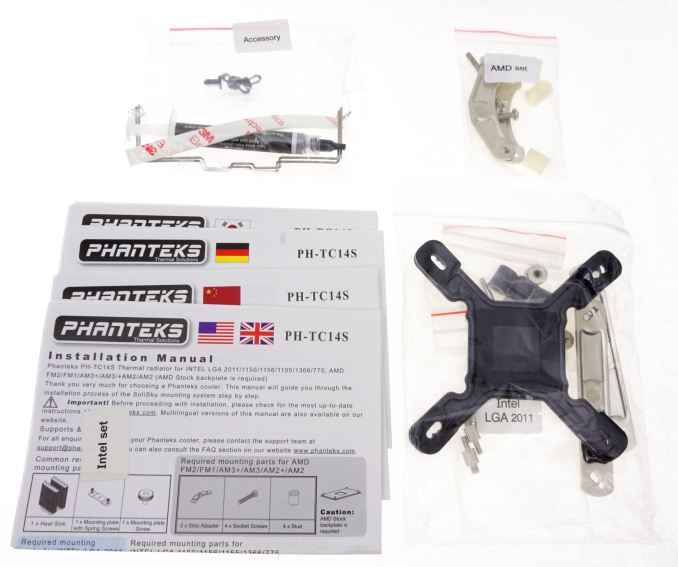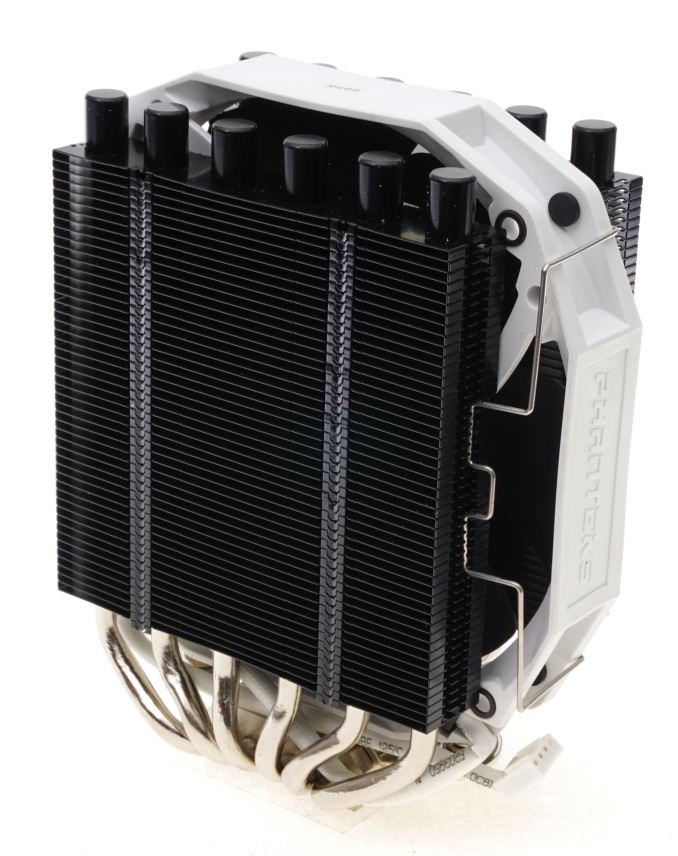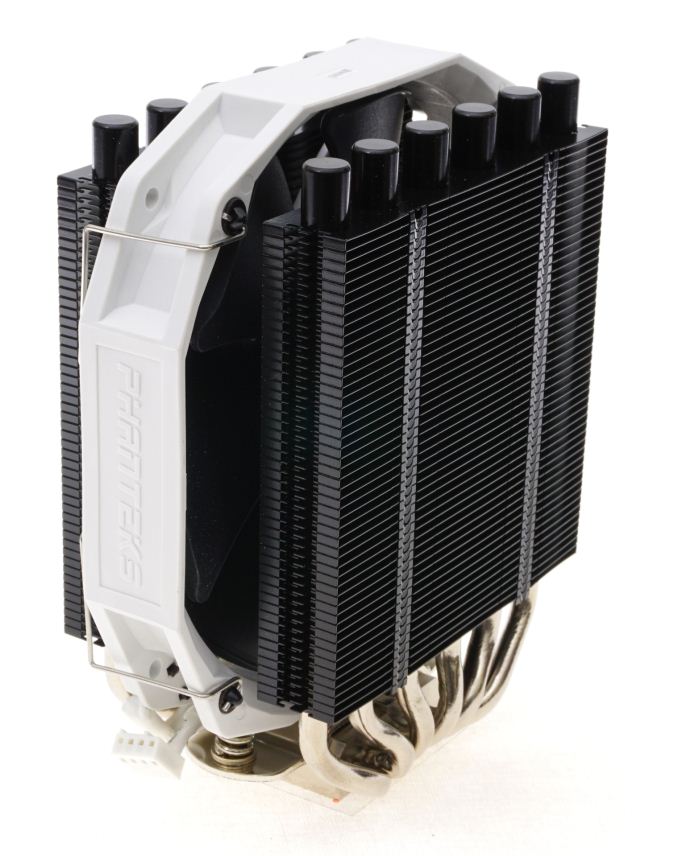The 140mm Slim Tower CPU Cooler Roundup: Thin & Light Done Just Right
by E. Fylladitakis on May 24, 2017 8:00 AM EST- Posted in
- Cases/Cooling/PSUs
- be quiet!
- Noctua
- Phanteks
- Cooler
- Thermalright
Phanteks PH-TC14S
Phanteks supplies the PH-TC14S inside a dark cardboard box with an abstract aesthetic theme, mostly based on schematic drawings of the cooler itself. It is not a very large box for a cooler that size, but it is very sturdy and the cooler is protected with polystyrene foam packaging, making it nearly impossible to damage during transport.
Inside the box we found four manuals, one for each of the most popular languages in the regions that the cooler is being marketed into, the necessary mounting hardware and a syringe with Phanteks PH-NDC thermal compound that should last for at least a couple of applications.
The Phanteks PH-TC14S is the “cheater” of this review, as it is not a single tower but a dual tower cooler design. It technically is a baby version of the monstrous PH-TC14PE that we had a look at a couple of years back. Still, this is Phanteks' only slim 140 mm tower cooler offering, and it is of comparable size to every other cooler in this roundup review. What the designers of Phanteks did was to split the single tower array into two very narrow arrays and place the 140 mm fan in between them. Strangely, the fins are significantly smaller than the fan without any apparent reason, meaning that there will be a significant loss of airflow to every direction.
The array fins are very thin and not strong individually, but they are soldered on the thick heatpipes that are only a few millimeters apart from each other. One major feature of the PH-TC14S is its black fins. Phanteks calls this paint job "Physical Antioxidant Thermal Shield" (or Physical Antioxidant Thermal Spraying - we found both in the company's texts) and claims that it enhances thermal performance by both increasing the dissipation rate of the heatsink itself and decreasing the radiation absorption rate from other heat sources. Unlike the PH-TC14PE, the PH-TC14S is available only in black.
The PH-F140HP fan also is a primary marketing focus of this product. It has the lowest RPM rating of every fan in this review (1300 RPM) but impressively high static pressure specifications (1.64 mm H2O at max speed).
Six thick heatpipes expand to either side of the small base. With the fin arrays placed in parallel, each heatpipe enters both arrays. Although that design appears very symmetric and effective at first, it actually does not appear to be optimal, as the two middle heatpipes that will be right above the CPU core and will be facing the bulk of the heat transfer enter near the fin arrays near the middle, where the fan’s airflow will be the lowest due to the dead spot under its motor.
The rectangular copper base of the PH-TC14S and the copper heatpipes are all nickel plated. Like with the majority of modern coolers, the base of the PH-TC14S is made of two parts, a copper contact plate and an aluminum top frame. The lower half of the base handles the thermal energy transfer away from the CPU and to the heatpipes, while the top half only offers mechanical cohesion and support for the steel mounting brackets. The nickel plated base is very smooth and machined down to a near-perfect mirror finish.
















74 Comments
View All Comments
guidryp - Wednesday, May 24, 2017 - link
IMO, it looks like the Thermalright is the the winner. It's the least expensive, and up to 150 watts, it keeps the lowest temperature. How many CPUs pull over 150 watts? Especially in real world workloads, not torture testing??JoeyJoJo123 - Wednesday, May 24, 2017 - link
That would seem to be the case here, yes. Performs as well as the Noctua (better than the Noctua at low loads and nearly equal at high loads), while being physically smaller, and cheaper, too.The black and silver finish is relatively attractive, too, but appearances are subjective anyways.
A5 - Wednesday, May 24, 2017 - link
Agreed, and I own the Noctua.I've had Thermalright products in the past and they were excellent as well.
ShieTar - Wednesday, May 24, 2017 - link
That only remains true if the CPU produces power over the same area as the thermal cartridge used in the test. The problem, specifically with Intels latest 4-Cores, is that they generate 100W on a much smaller area. Then the overall cooling capability and the vertical thermal resistance of the cooler become less relevant, and the lateral thermal resistance of the cooler base-plate becomes increasingly critical. That is why an i7-7700K will run much hotter than older CPUs with the same TDP, but much more die area.JoeyJoJo123 - Wednesday, May 24, 2017 - link
You're not wrong, but there's more to that story.It's also partially attributable to Intel's usage of poor TIM between the die and the integrated heatspreader, rather than their older usage of fluxless solder.
Intel's newer chips (due to smaller die sizes and poorer thermal interface for the integrated heatspreader) means that by the time the heat meets the heatsink vs integrated heatspreader contact area, it's not being dissipated as efficiently as older CPU models.
guidryp - Wednesday, May 24, 2017 - link
I think you have the situation backwards. The way the Thermalright excels at lower temperatures and it's direct heatpipe design indicate it has superb transfer from the socket.It only falls behind later when when the smaller heatsink array can't dissipate it as quickly.
Eri Hyva - Wednesday, May 24, 2017 - link
Please, add a test with 9 volts.Arbie - Wednesday, May 24, 2017 - link
Other sites reviewing coolers (eg X-Bit Labs R.I.P.) have found ways to plot cooling ability vs noise level. That makes it much easier to evaluate and choose the best one. IIRC one site even got cost into the same picture. In any case, leaving the reader to separately juggle delta-T and dBA is weak.Galcobar - Thursday, May 25, 2017 - link
Gold standard for standardized testing the efficiency of noise to cooling is Silent PC Review.Unfortunately, the site suffered a serious lack of ad revenue and seemed to go into the media death spiral of lack of readership>lack of revenue>lack of content>lack of readership. Hasn't been a posting since August.
snarfbot - Wednesday, May 24, 2017 - link
Well the article measures perf as shipped which while good is not apples to apples as they all use diff fans. They should be measured separately with the same fan installed into each to take fan speed, voltage and noise out of the equation.